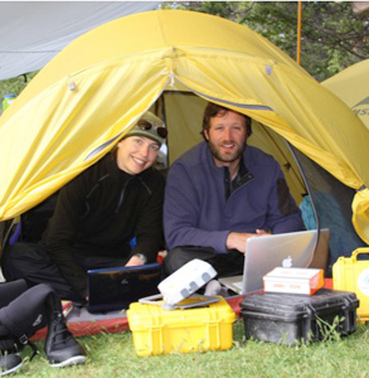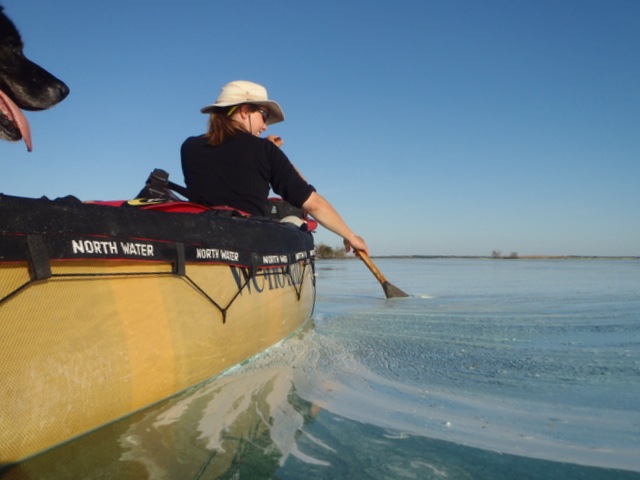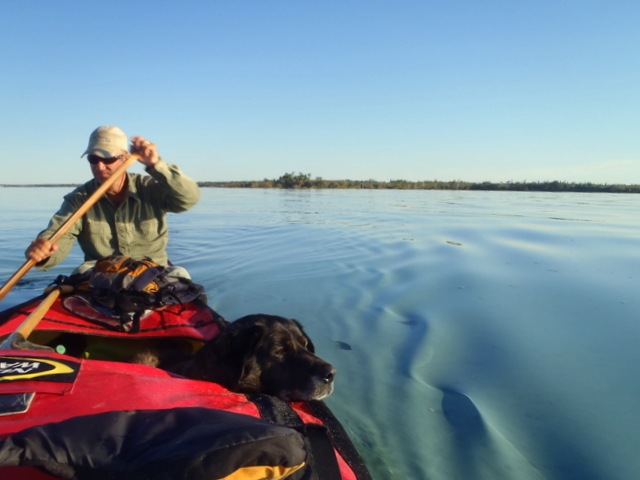ASC teams up with the Wilderness Classroom to study water quality and bird migration in the name of science and adventure
For the past three years, Dave and Amy Freeman have been trekking across North America on an 11,700 mile odyssey, during which they’ve traveled via dogsled, canoe and kayak. In the third and final 5,000 mile leg of the journey, Dave and Amy have partnered with Adventurers and Scientists for Conservation to contribute data to two studies as they kayak the Great Lakes to the Atlantic Ocean on south to the Florida Keys.
When they’re not collecting data for ASC, the Freemans operate Wilderness Classroom, a Minnesota-based program designed to educate young students about wild ecosystems through live presentations and internet seminars from remote locales. According to Dave, the program participants tend to respond to the adventure aspect with enthusiasm.
“The teachers use scientific data that we collect like temperature or miles traveled, and they’ll use that for graphing exercises, but I think the students like the animals and the sense of adventure, like the sled dogs. Those types of things are the hooks that really get the kids excited. It’s a good way to incorporate reading and math and critical thinking and all sorts of basic skills that come along with that,” Freeman said.
When they’re not collecting data for ASC, the Freemans operate Wilderness Classroom, a Minnesota-based program designed to educate young students about wild ecosystems through live presentations and internet seminars from remote locales. According to Dave, the program participants tend to respond to the adventure aspect with enthusiasm.
“The teachers use scientific data that we collect like temperature or miles traveled, and they’ll use that for graphing exercises, but I think the students like the animals and the sense of adventure, like the sled dogs. Those types of things are the hooks that really get the kids excited. It’s a good way to incorporate reading and math and critical thinking and all sorts of basic skills that come along with that,” Freeman said.
Dave said Wilderness Classroom parallels the mission of ASC by injecting an equal dose of adventure and ecological science into participating classrooms. Since its inception in 2001, the non-profit has worked with 2,400 teachers and engaged over 75,000 students.
The Freemans’ relationship with ASC, however, is a recent endeavor. Amy was introduced to the organization when she met founder Gregg Treinish at an Outdoor Retailer expo in Salt Lake City, Utah. After the two spoke, the Freemans knew they wanted to get Wilderness Classroom involved.
“We had our three year project, and had already done the first two years, and we were well under way. We thought it would be interesting to try and collect some data,” Dave said.
According to Dave, Wilderness Classroom had been searching for research opportunities prior to discovering ASC, never able to find the proper fit.
“We had contacted scientists directly to collect data in the past, but it hadn’t been a streamlined process, all the systems weren’t in place,” Dave said. “ASC’s main role is facilitating those connections, and it’s worked really well. It adds to Wilderness Classroom to add that data collection and scientific component to it.”
Dave and Amy just wrapped up participation in the Water Quality Monitoring study in the Great Lakes, where volunteers collect data by dropping a Secchi Disk, an eight-inch diameter disk featuring four alternating black-and-white sections connected to a line, into the water. When no longer visible, the depth at which the disk disappears is recorded along with location.
The Freemans’ relationship with ASC, however, is a recent endeavor. Amy was introduced to the organization when she met founder Gregg Treinish at an Outdoor Retailer expo in Salt Lake City, Utah. After the two spoke, the Freemans knew they wanted to get Wilderness Classroom involved.
“We had our three year project, and had already done the first two years, and we were well under way. We thought it would be interesting to try and collect some data,” Dave said.
According to Dave, Wilderness Classroom had been searching for research opportunities prior to discovering ASC, never able to find the proper fit.
“We had contacted scientists directly to collect data in the past, but it hadn’t been a streamlined process, all the systems weren’t in place,” Dave said. “ASC’s main role is facilitating those connections, and it’s worked really well. It adds to Wilderness Classroom to add that data collection and scientific component to it.”
Dave and Amy just wrapped up participation in the Water Quality Monitoring study in the Great Lakes, where volunteers collect data by dropping a Secchi Disk, an eight-inch diameter disk featuring four alternating black-and-white sections connected to a line, into the water. When no longer visible, the depth at which the disk disappears is recorded along with location.
This data helps define a water column’s turbidity, the cloudiness of a fluid caused by individual particles. Turbidity is a crucial component in determining cleanliness of water. The Freemans saw a wide range of disk readings that varied depending on location in the lake, from one and a half feet down to the Secchi Disk’s terminal line length of fifty five feet.
“We would try to collect two to four readings a day,” Dave said. “Sometimes it would disappear after a few feet, and sometimes we’d drop it down and let out all the line and still see it. Helping scientists understand how the Great Lakes are faring environmental changes seemed like a good cause to work on.”
As the Freemans’ paddle strokes pushed them from the Great Lakes to the Atlantic Ocean, their focus switched to the Banded Gulls on the Atlantic Coast project. By spotting and recording the locations of banded gulls, researchers can determine the cause of fluctuating bird populations. Getting relevant data for the Banded Gulls study hasn’t been a cake walk, however, marking the Freemans’ biggest obstacle in successfully completing their ASC mission.
“We saw one gull that was banded, but it was flying, so we couldn’t read the numbers on the band,” Dave said. “So far we have not been able to collect enough data for them but we’re always looking, we’ll see more further south. That’s been an interesting process, it got us to get out the binoculars and really look closely at the shoreline.”
But it’s just another day in the office as the Freemans paddle South through the winter, with plans to arrive in Key West sometime in spring next year.
As for data collection, the team will continue to search for gulls as both groups migrate south to warmer climates. Dave said it’s a commitment that requires some time investment to properly participate.
“We have to take time to do the readings,” Dave said. “But I think it’s a good thing to do, it adds value for ASC as well as Wilderness Classroom.”
~ Dylan Jones
“We would try to collect two to four readings a day,” Dave said. “Sometimes it would disappear after a few feet, and sometimes we’d drop it down and let out all the line and still see it. Helping scientists understand how the Great Lakes are faring environmental changes seemed like a good cause to work on.”
As the Freemans’ paddle strokes pushed them from the Great Lakes to the Atlantic Ocean, their focus switched to the Banded Gulls on the Atlantic Coast project. By spotting and recording the locations of banded gulls, researchers can determine the cause of fluctuating bird populations. Getting relevant data for the Banded Gulls study hasn’t been a cake walk, however, marking the Freemans’ biggest obstacle in successfully completing their ASC mission.
“We saw one gull that was banded, but it was flying, so we couldn’t read the numbers on the band,” Dave said. “So far we have not been able to collect enough data for them but we’re always looking, we’ll see more further south. That’s been an interesting process, it got us to get out the binoculars and really look closely at the shoreline.”
But it’s just another day in the office as the Freemans paddle South through the winter, with plans to arrive in Key West sometime in spring next year.
As for data collection, the team will continue to search for gulls as both groups migrate south to warmer climates. Dave said it’s a commitment that requires some time investment to properly participate.
“We have to take time to do the readings,” Dave said. “But I think it’s a good thing to do, it adds value for ASC as well as Wilderness Classroom.”
~ Dylan Jones



